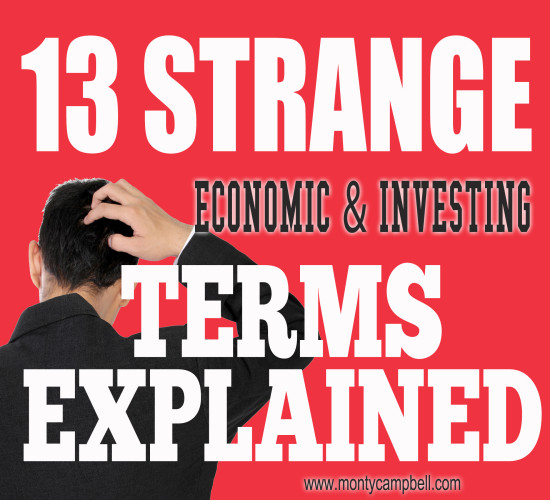Have you ever opened-up the business section of a newspaper or listened to the nightly business news and wondered – what the heck are they talking about? The world of Wall Street certainly has it’s own language and that language is full of vague phrases, jargon and acronyms that can bewilder even the most seasoned wealth builder. Just when you think you have money’s language down and feel conversant with its terminology, you’ll inevitably hear some phrase or saying that leaves you baffled. I’ve collected a few these below and explained them in layman’s terms!
1. Arbitrage. Arbitrage is simply buying an asset in one market and then simultaneously selling an identical asset in another market at a higher price. The person doing the arbitrage (arbitrageur) is looking to exploit the differences in price. For example, if Company ABC’s stock trades at $5.00 per share on the NASDAQ stock exchange and the equivalent of $5.05 on the London Stock Exchange (LSE), an arbitrageur would purchase the stock for $5 on the NASDAQ and sell it on the LSE for $5.05 — pocketing the difference of $0.05 per share. If you’ve ever purchased a bargain-priced item at a garage sale or flea market, and then sold that item for a higher price on eBay, then you’ve used arbitrage!
2. Derivatives. A derivative is anything that has its value based upon some other asset. In other words, it derives its value from something else. The most common “other assets” include stocks, bonds and commodities. But derivatives can also based on other things like currencies, interest rates and market indexes. Options are probably the most common form of a derivative. An option is simply a contract between two parties giving one the opportunity to buy or sell an asset from or to the other party at a future date. The option derives its price from the price of the asset.
3. Dead Cat Bounce. A dead cat bounce simply refers to a temporary increase in the stock market after a significant downward trend. For example, let’s assume the market has been falling over the last three weeks but then there is a market rally in week four. If the rally is short-lived and the market continues to fall again in week five, the rally in week four is considered a dead cat bounce.
4. Elasticity. Elasticity is the measurement of how demand for something will be affected by changes in its price. In other words, it’s a way to figure out how responsive consumers are to a change in price. Things are more of less “elastic” based on if they are a necessity or not. For example, if the price of light bulbs increases it probably won’t stop you from buying light bulbs because you need them. However, if the price of movie tickets were to suddenly skyrocket to $1,000 a piece, consumers would very well purchase less movie tickets because they are not a necessity. In these examples, the price of light bulbs would be considered inelastic while the price of movie tickets would be elastic, or more sensitive to changes in price.
5. Fed Funds Rate. The Federal Funds Rate is the rate that banks charge each other for overnight loans. Why would one bank borrow cash from another? The Fed can require banks to keep a certain percentage of assets in the form of cash on hand or deposited in one of the Federal Reserve banks. The increased (or decreased) cost of acquiring funds is passed on to consumers in the form of interest rates for loans such as mortgages and auto loans, as banks adjust their lending rates to compensate. Also, many credit cards base the interest rate you pay on a premium above the Fed Funds Rate.
6. Fungible. Something is fungible when any one single thing is indistinguishable from any other. Commodities, common shares of a company and dollar bills are examples of fungibles. Somebody who is owed $1 does not care which particular dollar he gets. Anything that people want to use as money must be fungible, whether it be gold bars, beads or shells.
7. Goldilocks Economy. A Goldilocks Economy is when the economy’s growth isn’t too hot, causing inflation, nor too cold, creating a recession. It’s an ideal growth rate of between 2-3%, with the idea being to create enough demand to keep the economy humming at a healthy pace but not too much so that it overheats and enters into an inflationary period. This healthy economy is named after the famous children’s story, Goldilocks and the Three Bears!
8. Liquidity Trap. This is a situation when money policy does the opposite of what it is supposed to do. Generally, lowering interest rates boosts the economy out of a recession. But sometimes cutting interest rates doesn’t turn the economy around right away. People, banks and companies can become so risk averse that they prefer the liquidity of cash to offering or using credit. When this happens, the economy would be trapped in a recession, despite the best efforts of money policymakers.
9. Margin Call. A margin call is a brokerage firm’s demand that an investing client deposit securities or cash into their account in order to bring the account balance up to a minimum amount. Some brokerage customers are allowed to borrow money from the brokerage firm to buy stocks (buying on margin). If the value of the customer’s account holdings fall below a certain level, the brokerage firm will force the client to deposit cash, or securities, to offset the difference. This demand is known as a margin call.
10. Opportunity Cost. Opportunity cost quantifies the most basic of economic principles: trade-offs. Opportunity cost is part of every decision of daily life and certainly of investing: if you make a choice, you forgo the other options for now. And what’s been given up can sometimes turn out to have been the wiser choice, which is why opportunity cost is best measured in hindsight — after all, it is impossible to know the end outcome of any investment.
11. Shorting. The typical way people think of investing is to buy a stock first, which is called going “long”, and then to sell it at some later date. Obviously, when you go long you expect the price to rise in the future. Shorting is just the same thing in reverse — instead of buying first, you sell first (go short) and then buy back later, preferably at a lower price. Again, the profit or loss is the difference between the two prices. The natural question here is “How do you sell something that you don’t have?” The answer is that you borrow it!
12. Time Value Of Money. You’ve probably heard the phrase “a bird in the hand is worth more than two in the bush.” That’s essentially saying that a dollar today is worth more than a dollar received in the future, which is the essence of the time value of money. One reason that money has a “time value” is that money received today can be invested, thus generating more money. Another reason is that when a person chooses to receive a sum of money in the future rather than today, he or she is effectively lending the money and there are risks involved in lending such as the risk the other person will default on the loan and also the risk of inflation.
13. Triple Witching. This is sometimes referred to as ‘freaky Friday,’ and occurs on the third Friday of every March, June, September and December when stock options, stock market index options and stock market index futures all expire on the same day. This leads to increased stock market trading and volatility as traders try to offset their investments before the market closes.
Jargon and acronyms are par for the course in the world of money. But don’t despair if you sometimes feel lost. The trick is not to get intimidated by it, but rather to simplify it so that it makes sense to you.
Wall Street jargon has the potential to promote confusion which leads to apathy, which leads to a person not paying enough attention to their money. Don’t be that person. If you’re stuck understanding something, ask someone for help, or better yet, use the comments section below to ask your question!
Be free. Nothing else is worth it.
Want even more financial freedom topics demystified? Check-out these other articles from the blog archives:
Shocking Statistics About Personal Finance In America… That Will Make You Cringe!
Stephen Curry Cut His Own Path To Greatness. How You Too Can Escape The Jungle Of Mediocrity!
The Little White Lie (You Know The One), That Keeps People Stuck In The Middle Class




